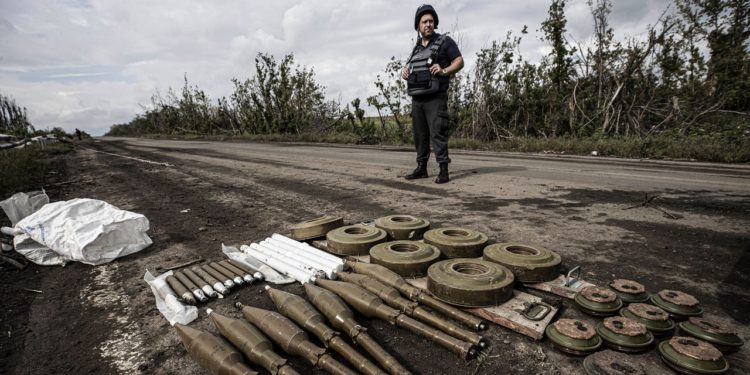By WIRED
Oleksandr Kryvtsov had enough.
The owner of an agricultural company in Hrakove, near Kharkiv, Kryvtsov found his land littered with land mines. That region of Ukraine, occupied by Russian forces for nearly eight months, had been pockmarked with explosive ordinances. The threat meant that farmers like Kryvtsov had to let their fields lay fallow. Even though Kryvstov’s fields were once part of Europe’s breadbasket, Ukraine’s mine clearance teams were overworked and under-resourced.
So Kryvtsov came up with his own solution. He jimmyrigged a plow onto an old tractor, with massive steel rollers underneath. On the side, he painted the yellow and blue Ukrainian flag. Kryvtsov connected a remote-control steering system and, from afar, he drove his Mad Max-style tractor over his fields, detonating any mines lurking under the soil.
The makeshift operation has worked well, Kryvtsov told Reuters, even clearing an anti-tank mine.
Kryvstov’s story is an example of incredible Ukrainian ingenuity—a nation of gilders, working to invent, adapt, and repurpose technology to defend themselves against a better-resourced, larger, determined enemy. But it’s also an ominous sign of just how bad the problem is.
In recent months, WIRED has investigated the technological challenges and opportunities facing Ukraine as it tries to defend itself and recapture its territory. One particular problem, unsung by the Western media but frequently cited by Ukrainian officials, are the haphazard minefields across Eastern Ukraine.
WIRED has spoken to a range of engineers, government officials, and humanitarian mine-clearance experts, and consulted Ukraine’s new mine clearance plan. It is apparent that Kyiv is prioritizing the problem, but without a significant new influx of money, personnel, and technology, the threat of these mines could hobble Ukraine’s economy, frustrate future counteroffensives, and pose a humanitarian crisis for decades to come.
A Humanitarian Crisis, an Economic Cost
Ukraine’s mine problem has been acute for a decade. The full-scale war with Russia has only made it worse. From 2014, when Russia first invaded, to the end of 2021, the United Nations says 312 Ukraines were killed by land mines. Since Russia’s February 2022 invasion, Ukraine has recorded at least 269 civilian casualties, including 14 children. Prime Minister Denys Shmyhal has taken to calling Eastern Ukraine “the largest minefield in the world.”
Those casualty figures only capture the deaths on territory currently held by Ukraine. Behind the front lines, in the Russian-occupied regions of Eastern Ukraine, at least a hundred more have reportedly been killed.
“Twenty percent of the whole territory is dangerous,” Ihor Bezkaravainyi, Ukraine’s deputy minister of finance, tells WIRED. “Right now we’re talking about 150,000 square kilometers.” (The total area, including water littered with naval mines, is nearly 175,000 km².)
Bezkaravainyi is a veteran of the war in Eastern Ukraine—he lost a leg to an anti-tank mine in 2016. He’s now responsible for coordinating the mine-clearance effort behind the front lines, giving Ukrainians back their property and recovering damaged agricultural lands. It’s not an easy task.
“It looks like the zone rogue in France after World War One,” Bezkaravainyi says, referring to the areas near Germany and Belgium that remain contaminated by land mines to this day.







Discussion about this post